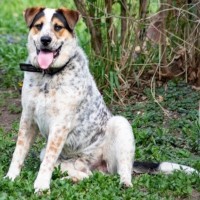Appearance of the Dalmatian Heeler
|
| It's always difficult to say with certainty what a hybrid dog will look like, due to which parent it takes after most, or which characteristics are most dominant. While the Blue Heeler parent (Australian Cattle Dog) is robust and compact with a well-muscled body, the Dalmatian is a big, strong dog with an athletic look. Your Dalmatian Heeler could be a combination of the two, or take either parent. The chest is deep, the tail straight and held moderately low. The head is slightly rounded, with large ears set high on the head but hanging down, or they may stand upright. The eyes are round and may have the characteristic blue-brown or a combination of the two colors like the Dalmatian. The front legs are strong and straight, and the feet are rounded and arched. Due to the mixed parentage of Dalmatian Heelers, they are available in a wide range of colors, patterns and coat types, making them an attractive dog. |
Temperament of the Dalmatian Heeler
|
| The Dalmatian Heeler is a loyal and courageous dog, with great energy and stamina. Not a dog to stay at home and do nothing, it needs plenty of exercise to avoid boredom, which can lead to behavioral problems such as digging crater-sized holes in your garden. This alert, active dog is excellent in the obedience ring and will excel in agility and breeding trials. Firm but benevolent leadership is required with this dog, he can be sensitive to stern leadership like the Dalmatian, so be consistent in your training and reward him with praise and affection. If your dog is not properly socialized as a puppy, he may become aggressive with other dogs as he grows. Lots of outings and exercise while mixing with other people and dogs is a must. The Dalmatian Heeler may nip at people's heels in an attempt to herd them (like their Blue Heeler relative nips at cattle), so the owner must teach the dog that this is not acceptable. These dogs do well in the country, or if they get enough exercise, they can adapt to city life. Their playfulness, loyalty, devotion and affection make them ideal family dogs. |
Needs and activities of the Dalmatian Heeler
|
| These dogs have great stamina and will appreciate as much exercise as you can give them. They are ideal as jogging partners and are almost tireless. They love games that challenge their intellect, such as obstacle courses or obedience classes. They have a natural instinct for stalking or herding, and are great retrievers. The Dalmatian Heeler has a strong nature, so it needs a good pack leader, but will be devoted and loyal to its owner. |
Maintenance of the Dalmatian Heeler
|
| Bathe your hybrid only when necessary to preserve its waterproof coat. Using a specially formulated dog shampoo will help prevent the development of dry or allergic skin. Your Dalmatian Heeler is quite soft, so frequent brushing with a firm bristle brush will be necessary to prevent the coat from matting. Some dogs may have more Australian Cattle Dog coat, which is short and easy to groom, but it still sheds twice a year, requiring extra maintenance at these times. Other grooming needs include ear care, nail trimming and tooth brushing. If your dog is trained to accept this period as a normal part of his life from an early age, it will be easier to maintain your dog's health and help him during visits to the veterinary clinic. |









 English (United Kingdom)
English (United Kingdom)